54 Results

By the end of this section, you will be able to:
Show the relationship between production costs and comparative advantage
Identify situations of mutually beneficial trade
Identify trade benefits by considering opportunity costs
- Subject:
- Applied Science
- Material Type:
- Module
- Date Added:
- 09/20/2018

- Subject:
- Economics
- Social Science
- Material Type:
- Unit of Study
- Provider:
- Rice University
- Provider Set:
- OpenStax College
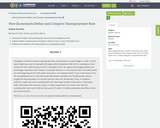
By the end of this section, you will be able to:
Calculate the labor force participation rate and the unemployment rate
Explain hidden unemployment and what it means to be in or out of the labor force
Evaluate the collection and interpretation of unemployment data
- Subject:
- Applied Science
- Material Type:
- Module
- Date Added:
- 09/20/2018

14.01 Principles of Microeconomics is an introductory undergraduate course that teaches the fundamentals of microeconomics. This course introduces microeconomic concepts and analysis, supply and demand analysis, theories of the firm and individual behavior, competition and monopoly, and welfare economics. Students will also be introduced to the use of microeconomic applications to address problems in current economic policy throughout the semester.
This course is a core subject in MIT’s undergraduate Energy Studies Minor. This Institute-wide program complements the deep expertise obtained in any major with a broad understanding of the interlinked realms of science, technology, and social sciences as they relate to energy and associated environmental challenges.
Course Format
This course has been designed for independent study. It includes all of the materials you will need to understand the concepts covered in this subject. The materials in this course include:
A complete set of Lecture Videos by Prof. Jon Gruber.
Reading Assignments in your choice of two textbooks – one of which is a free online edition - as preparation for the lectures.
Multiple-choice Quizzes to assess your understanding of the key concepts in each session.
Problem Sets with solution keys to test your ability to apply to concepts covered in lecture, and Problem Solving Videos to provide step-by-step instruction through several problem set solutions.
A collection of links For Further Study to provide supplemental online content.
A full set of Exams, including review material and practice exams to help you prepare.
- Subject:
- Economics
- Social Science
- Material Type:
- Full Course
- Provider Set:
- MIT OpenCourseWare
- Author:
- Gruber, Jonathan
- Date Added:
- 09/01/2011
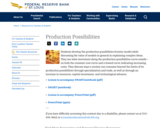
Students develop the production possibilities frontier model while discussing the value of models in general in explaining complex ideas. They see what movement along the production possibilities curve entails on both the constant-cost curve and a bowed curve indicating increasing costs. They discuss ways a society can consume beyond the limits of its production possibilities through specialization and trade, as well as through an increase in resources, capital investment, and technological advance.
- Subject:
- Economics
- Social Science
- Material Type:
- Lesson
- Lesson Plan
- Provider:
- Federal Reserve Bank of St. Louis
- Provider Set:
- Economic Lowdown Lessons
- Author:
- Barbara Flowers
- Date Added:
- 10/06/2014

This course covers techniques of financial analysis of investment expenditures as well as the economic and distributive appraisal of those projects. The course gives special consideration to cases in the developing world. Students will engage in a critical analysis of these tools and their role in the political economy of international development. The course will cover topics such as alternative planning strategies for conditions of uncertainty; organizations and project cycle management; the political environment; and interactions of clients and advisers, engineers, planners, policy analysts, and other professionals.
Introductory micro-economics is a pre-requisite for this course.
- Subject:
- Economics
- Social Science
- Material Type:
- Full Course
- Provider Set:
- MIT OpenCourseWare
- Author:
- Kim, Annette
- Date Added:
- 02/01/2005
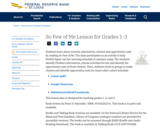
tudents learn about scarcity, alternatives, choices and opportunity costs by reading So Few of Me. The class participates in an activity to help Perdita figure out her morning schedule at summer camp. The students identify Perdita's alternatives, choose activities for her and identify the opportunity costs of those choices. Then, students work in groups to make choices and identify opportunity costs for Juan's after-school schedule.
- Subject:
- Economics
- English Language Arts
- Social Science
- Material Type:
- Lesson
- Lesson Plan
- Reading
- Provider:
- Federal Reserve Bank of St. Louis
- Provider Set:
- Economic Lowdown Lessons
- Author:
- Andrew T. Hill
- Date Added:
- 09/11/2019

In this lesson, students learn about the act of saving and how the accumulation of money saved is termed savings. They are read a story about a family that saves and how savings can be used to make a large purchase the family would not ordinarily be able to make. They recognize that there is an opportunity cost to saving, as well as an opportunity cost to spending.
- Subject:
- Economics
- English Language Arts
- Social Science
- Material Type:
- Lesson
- Lesson Plan
- Reading
- Provider:
- Federal Reserve Bank of St. Louis
- Provider Set:
- Economic Lowdown Lessons
- Author:
- Barbara Flowers
- Date Added:
- 09/11/2019
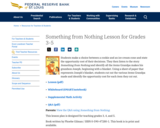
Students make a choice between a cookie and an ice cream cone and state the opportunity cost of their decisions. They then listen to the story Something from Nothing and identify all the items Grandpa makes his grandson Joseph, beginning with a blanket. Using a sheet of paper that represents Joseph's blanket, students cut out the various items Grandpa made and identify the opportunity cost for each item they cut out.
- Subject:
- Economics
- English Language Arts
- Social Science
- Material Type:
- Lesson
- Lesson Plan
- Reading
- Provider:
- Federal Reserve Bank of St. Louis
- Provider Set:
- Economic Lowdown Lessons
- Author:
- Barbara Flowers
- Bonnie Meszaros
- Judy Austin
- Date Added:
- 09/11/2019
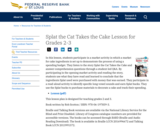
In this lesson, students participate in a market activity in which a market for cake ingredients is set up to demonstrate the process of using a spending budget. They listen to the story Splat the Cat Takes the Cake and answer comprehension questions through a student-led Q&A. By participating in the opening market activity and reading the story, students use what they have read and learned to conclude that the ingredients Splat used were purchased with money that was earned. They participate in a read-aloud activity to identify specific long-vowel sounds and earn Splat bucks. They use the Splat bucks to purchase materials to decorate a cake and track their spending.
- Subject:
- Economics
- English Language Arts
- Social Science
- Material Type:
- Lesson
- Lesson Plan
- Reading
- Provider:
- Federal Reserve Bank of St. Louis
- Provider Set:
- Economic Lowdown Lessons
- Author:
- Andrea J. Caceres-Santamaria
- Date Added:
- 09/11/2019

The study of economics is built on the foundation of three very important concepts: scarcity, choice, and opportunity cost. In this episode of the Economic Lowdown video series, economic education Coordinator Scott Wolla uses these three concepts to explain why there is no such thing as a free lunch.
- Subject:
- Economics
- Social Science
- Material Type:
- Lecture
- Provider:
- Federal Reserve Bank of St. Louis
- Provider Set:
- Economic Lowdown Videos
- Date Added:
- 09/11/2019
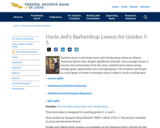
Students listen to the book Uncle Jed's Barbershop, about an African-American barber who, despite significant setbacks, saves enough money to buy his own barbershop. From the story, students learn about saving, savings goals, opportunity cost, and segregation. The students participate in a card game to further investigate what it takes to reach a savings goal.
- Subject:
- Economics
- English Language Arts
- Social Science
- Material Type:
- Lesson
- Lesson Plan
- Reading
- Provider:
- Federal Reserve Bank of St. Louis
- Provider Set:
- Economic Lowdown Lessons
- Author:
- Andrew T. Hill
- Date Added:
- 09/11/2019

